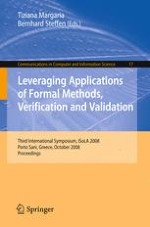This volume contains the conference proceedings of ISoLA 2008, the Third International Symposium on Leveraging Applications of Formal Methods, Verification and Validation, which was held in Porto Sani (Kassandra, Chalkidiki), Greece during October 13–15, 2008, sponsored by EASST and in cooperation with the IEEE Technical Committee on Complex Systems. Following the tradition of its forerunners in 2004 and 2006 in Cyprus, and the ISoLA Workshops in Greenbelt (USA) in 2005 and in Poitiers (France) in 2007, ISoLA 2008 provided a forum for developers, users, and researchers to discuss issues related to the adoption and use of rigorous tools and methods for the specification, analysis, verification, certification, construction, test, and maintenance of systems from the point of view of their different application domains. Thus, the ISoLA series of events serves the purpose of bridging the gap between designers and developers of rigorous tools, and users in engineering and in other disciplines, and to foster and exploit synergetic relationships among scientists, engineers, software developers, decision makers, and other critical thinkers in companies and organizations. In p- ticular, by providing a venue for the discussion of common problems, requirements, algorithms, methodologies, and practices, ISoLA aims at supporting researchers in their quest to improve the utility, reliability, flexibility, and efficiency of tools for building systems, and users in their search for adequate solutions to their problems.
